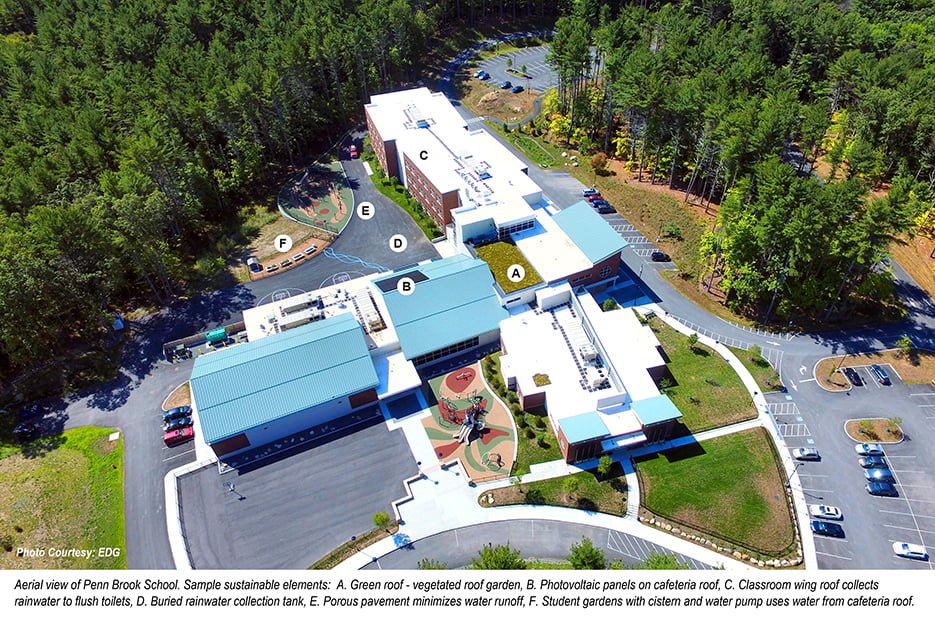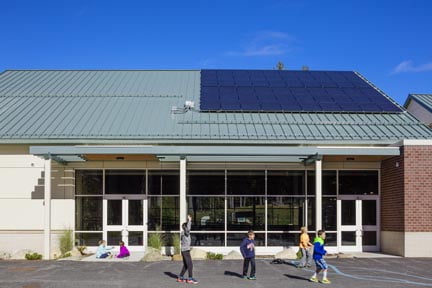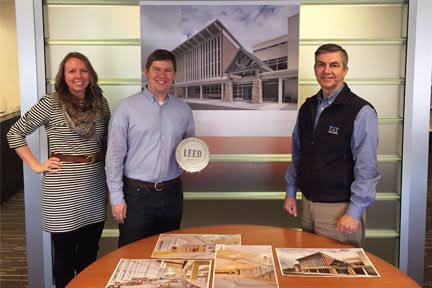Penn Brook School Achieves LEED Silver Certification
The Penn Brook Elementary School in Georgetown, Massachusetts recently received LEED Silver Certification, this is the first building in the town to achieve this goal. Drummey Rosane Anderson (DRA), is the architect of the new three-story elementary school that is designed for 770 students in kindergarten through sixth grade. Each grade has five classrooms organized in classroom ‘pods’ with breakout spaces designed in the hallway areas. Special learning spaces include art, computer room, music and band, plus interactive learning spaces outside.
‘The School in the Woods’, as the new Penn Brook School has been dubbed, allows spaces throughout the interior to have views to the surrounding site. The large library/media center is centrally located with views towards the surrounding trees. Classroom spaces have large windows that open to the woodland views around the site and branch off the centrally located, shared spaces such as the administration building, library and cafeteria.
Entries are identified by playful gabled roofs reminiscent of mountain lodges, but scaled and detailed to cater to the school community and younger audience. The kindergarten wing has story-telling areas that are highlighted on the exterior with special gabled roofs and fun window concepts such as circles and stacked block shapes.
The interior design concept connects elements found in nature that are also found in the local region. The color palette is derived from earth tones and water elements found throughout the schools site. The Cafetorium, Media Center and Corridors all have multipurpose components. Each have areas where benches and soft seating are used to provide spaces for small groups to view nature while interacting with each other.
Each level has a different view through the trees to the woods beyond. The third floor of the classroom wing looks out to a vegetated roof garden and the trees beyond.
Sustainable Features

The ‘fresh air’ system allows notification to classroom teachers via a green light when the outside temperature and humidity levels are appropriate for opening windows, thus reducing the amount of energy required by the HVAC equipment in the classroom wing. These units are zoned for east and west exposure for this portion of the building. Operable windows are in every classroom space to allow students and teachers to aid in the energy-saving process.
Toilet rooms in the student wing utilize recycled rainwater from the roof above. The rainwater collection system and pump are in the boiler room, which is fed from the 7,000-gallon tank on site that holds the water for reuse. This, in combination with the low flow fixtures installed in the school, reduce the overall consumption of domestic water use by the school.

Rainwater from the cafetorium roof is collected in a rain garden and flows to an underground cistern used to water student gardens. These gardens are currently maintained from spring time through the fall by students attending the elementary school.
The gardens are integrated in the main play area that also has porous pavement to minimize rainwater runoff from the developed portion of the site. This reduces the impervious paved area considerably and allows for a large play surface on the south side of the building.
Photovoltaic panels are mounted on the south side of the cafetorium roof to reduce the overall energy consumption of the school. The design meets 1% of the overall building energy load from equipment.
The school also has preferred parking for energy efficient and low-emitting vehicles.
The elementary school was completed in the fall of 2015 and the students are now enjoying their new, sustainable “School in the Woods”.

L to R: Courtney Southwick, Matthew Heaton, and Principal, Carl Franceschi, AIA, LEED AP.
